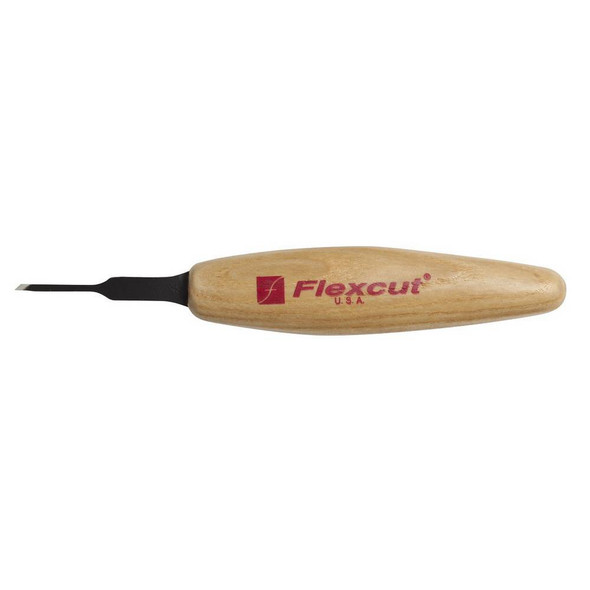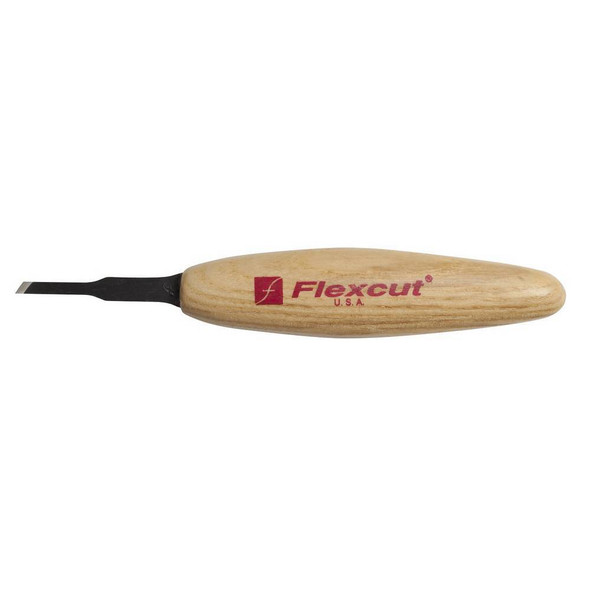#2 Gouge, Skew Gouges
- Product
- Qty in Cart
- Quantity
- Price
- Subtotal
-

Flexcut Micro Skew 3/16" (5mm)
Flexcut
MSRP: $22.95$19.95The Flexcut is a fixed handle micro tool with 3/16" (5 mm) wide from wing to wing. The Flexcut skew features a flexible spring steel shank that conforms to the contours of your projects surface to give you maximum control over every cut...MSRP: $22.95$19.95 -

Ramelson Standard #2 x 9/64" Straight Gouge Straight Handle
Ramelson
$13.95Ramelson Standard #2 x 9/64" Straight Gouge Straight Handle The Ramelson Standard #2 x 9/64" Straight Gouge Straight Handle is ideal for every carver's collection. Each straight gouge is made from W-1 US Tool Steel with a Rockwell...$13.95 -

Flexcut Interchangeable Blade #2 X 5/16" (8mm) Skew
Flexcut
MSRP: $15.95$14.95The Flexcut Interchangeable #2 X 5/16 (8mm) Skew features a flexible spring steel shank that conforms to the contours of your projects surface to give you maximum control over every cut. The wide variety of shapes it can attain...MSRP: $15.95$14.95 -

Flexcut #2 X 9/16 Long Handle Skew
Flexcut
$16.28This unique Flexcut skew knife is designed for the lowest resistance cut possible. The skewed end offers a guillotine-like slicing action allowing smooth, against the grain cuts in awkward positions,which is great for making detailed cuts that are very...$16.28 -

Flexcut Interchangeable Blade #2 x 9/16" (15mm) Double Bevel Skew
Flexcut
MSRP: $15.96$14.95Flexcut double bevel skew features a flat angled cutting edge or creating fine lines or adding depth to relief carvings. Weather your a woodcarver or sculptor these Flexcut gouges are perfect for define fine facial features or pairing away thin...MSRP: $15.96$14.95 -

Flexcut Mallet Skew #2 x 15/16"
Flexcut
$23.96Sometimes pushing tools by hand is not the most efficient way to go, especially when carving large projects or denser hardwoods. The mallet tools are designed with just that in mind. Handcrafted with the same long-lasting Flexcut razor edge, the Ash...$23.96 -

Flexcut Micro Skew 1/16" (1.5mm)
Flexcut
MSRP: $22.95$20.95The Flexcut is a fixed handle micro tool with 1/16" (1.5 mm) wide tip. The Flexcut chisel features a flexible spring steel shank that conforms to the contours of your projects surface to give you maximum control over every cut...MSRP: $22.95$20.95 -

Flexcut Micro Skew 1/4" (6mm)
Flexcut
MSRP: $21.95$18.95The Flexcut is a fixed handle micro tool with 1/4" (6mm) wide from wing to wing. The Flexcut skew features a flexible spring steel shank that conforms to the contours of your projects surface to give you maximum control over every cut...MSRP: $21.95$18.95 -

Flexcut Micro Skew 1/8"
Flexcut
MSRP: $22.95$20.95Flexcut MT16 Micro Skew The Flexcut is a fixed handle micro tool with 1/18" (3 mm) wide tip. The Flexcut skew features a flexible spring steel shank that conforms to the contours of your projects surface to give you maximum control over...MSRP: $22.95$20.95 -


Flexcut Palm Double Bevel Skew #2 x 5/16 (8mm)
Flexcut
MSRP: $22.95$19.95The Flexcut Double Bevel Skew 5/16" is a premium tool that showcases exquisite craftsmanship. Its high carbon steel blade is exceptional for creating intricate designs with precision and speed. This tool's ash contoured handle provides maximum grip and...MSRP: $22.95$19.95 -


Flexcut Palm Skew #2 x 9/16
Flexcut
MSRP: $23.95$20.95Looking for a reliable tool for your woodworking needs? Look no further than the Flexcut! This fixed handle palm tool boasts a razor sharp #2 x 9/16" wide blade, making it perfect for achieving precision cuts with ease. T he Flexcut also features a...MSRP: $23.95$20.95 -
Power Grip 3.0mm Skew Chisel
$12.95Hey, students, these Power Grip Tools are very popular with carving teachers and economical for beginning students around the country. They are considered a fundamental tool when learning block print carving on wood for relief printing. The blades are...$12.95

